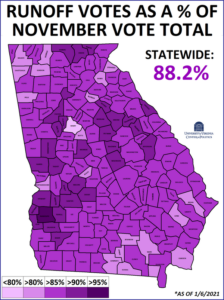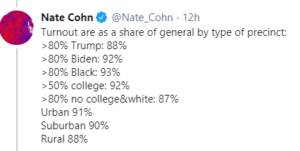Some insights from “Biden Begins Presidency With Positive Ratings; Trump Departs With Lowest-Ever Job Mark: 68% of public does not want Trump to remain a major political figure in the future,” based on a study by The Pew Research Center, “conducted Jan. 8-12 among 5,360 U.S. adults, including 4,040 who say they voted in the presidential election”:
As Joe Biden prepares to take office just days after a deadly riot inside the U.S. Capitol, 64% of voters express a positive opinion of his conduct since he won the November election. Majorities also approve of Biden’s Cabinet selections and how he has explained his plans and policies for the future.
Donald Trump is leaving the White House with the lowest job approval of his presidency (29%) and increasingly negative ratings for his post-election conduct. The share of voters who rate Trump’s conduct since the election as only fair or poor has risen from 68% in November to 76%, with virtually all of the increase coming in his “poor” ratings (62% now, 54% then).
Trump voters, in particular, have grown more critical of their candidate’s post-election conduct. The share of his supporters who describe his conduct as poor has doubled over the past two months, from 10% to 20%.
The study notes further that “About two-thirds (68%) say Trump should not continue to be a major national political figure for many years to come; just 29% say he should remain a major figure in U.S. politics.” Also, “A narrow majority of Americans (54%) say it would be better for the country for Trump to be removed from office, with Vice President Mike Pence finishing the last few days of his term…” However, “45% say Trump should remain in office until his term ends Jan. 20.”
The survey also found that “Among voters overall, 65% say Biden definitely or probably “received the most votes cast by eligible voters in enough states to win the election”; 54% say he definitely won the most votes.” Yet, “34% incorrectly say Trump definitely or probably was the rightful election winner.”
In addition, “57% – approve of Biden’s Cabinet choices and other high-level appointments. Almost half (46%) expect Biden to improve the way the federal government in Washington, D.C., works, while 28% say he will make things worse; 24% say he will not have much of an effect.”
Clearly, President-elect Biden and his fellow Democrats have reason to be hopeful that they have adequate political capital to enact major elements parts of their legislative agenda, such as pandemic vaccination acceleration and Biden’s stimulus proposals. But the thin margins they hold in congress will require successful bipartisan oputreach to enact many Democratic priorities.










